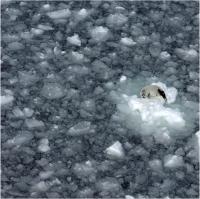
Dwindling sea ice is leaving vulnerable baby harp seals stranded in greater numbers, according to an analysis by the Duke Marine Lab and the International Fund for Animal Welfare. Young harp seals off the eastern coast of Canada are at much higher risk of getting stranded than adult seals because of shrinking sea ice cover caused by recent warming in the North Atlantic, according to a Duke University study.
"Stranding rates for the region's adult seals have generally not gone up as sea ice cover has declined; it's the young-of-the-year animals who are stranding (those less than one year old)," said David Johnston, a research scientist at Duke's Nicholas School of the Environment.
"And it's not just the weakest pups -- those with low genetic diversity and presumably lower ability to adapt to environmental changes -- that are stranding," he said. "It appears genetic fitness has little effect on this."
The study, published online this week in the peer-reviewed open-access journal PLoS One, is the first to gauge the relative roles that genetic, environmental and demographic factors such as age and gender may be playing in harp seal stranding rates along the U.S. and Canadian east coasts in recent years.
Harp seals rely on stable winter sea ice as safe platforms to give birth and nurse their young until the pups can swim, hunt and fend off predators for themselves. In years of extremely light ice cover, entire year-classes may be disappearing from the population, Johnston said.
The new study complements a Duke-led study published last year that found seasonal sea ice cover in all four harp seal breeding regions in the North Atlantic has declined by up to 6 percent a decade since 1979, when satellite records of ice conditions in the region began.
To expand upon the earlier study, Johnston and four colleagues at the Duke University Marine Lab compared images of winter ice from 1992 to 2010 in a major whelping region off Canada's east coast, the Gulf of St. Lawrence, with yearly reports of dead harp seal strandings along the U.S. northeast coast that were grouped by gender and estimated age of the seal.
The analysis revealed a significant difference: In years when ice cover was reduced, stranding rates for younger seals rose sharply, even though stranding rates for adult seals remained relatively stable.
The researchers also compared DNA samples from 106 harp seals that had been stranded ashore with those from seals that had accidentally been caught by fishing boats in the region during the same period.
"We used measures of genetic diversity to determine if the dead seals that came ashore were less fit than the presumably healthy ones that had been caught by fishermen, but found no difference," said Thomas Schultz, director of Duke's Marine Conservation Molecular Facility. "The stranded animals appear to have come from a genetically diverse population, and we have no evidence to suggest that genetic fitness played a role in their deaths."
The analysis also showed that male seals stranded more frequently than females during the study period, and that this relationship was strongest during light ice years.
"Our findings demonstrate that sea ice cover and demographic factors have a greater influence on harp seal stranding rates than genetic diversity," said Brianne Soulen, who co-led the study while she was a master's degree student in marine ecology at Duke.
Kristina Cammen, a Duke Ph.D. student who also co-led the study, said the findings "provide more context for what we're seeing in high-latitude species in general. The effects of climate change are acting on younger animals; it's affecting them during the crucial first part of their life."
Source : tdlucas@duke.edu
 Print Article
Print Article Mail to a Friend
Mail to a Friend
